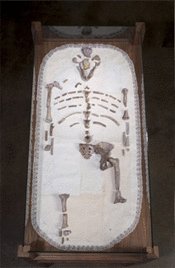Departing from the 'Pictures' generation's "laconic pillaging strategies," the fifteen artists in "Not Quite How I Remember It," at Toronto's The Power Plant, deploy "embodied and labor-intensive" attitudes toward history. As exhibition curator Helena Reckitt argues, in a text accompanying the exhibition, the relationship of these artists to their subject-matter is analogous to that of performer to script; mediums as diverse as sculpture, photography and installation thereby become stages and props in dramatic reprisals of the near and distant past. Among the more explicit examples of this, in the sculptural realm, is Dario Robleto's She Can't Dream for Us All (2005-6), which, as with many of the artist's other works, exists somewhere between the exhibited object (here a wooden bed covered with a partial skeleton) and the caption (informing, among other things, that the homemade paper under the skeleton was "pulp made from mothers', wives' and daughters' letters to soldiers in the field from various wars"). Beyond simply making contemporary art fit an image of the past, Robleto actually uses the materials of the past, but in so doing obliterates their value and legibility as historical relics. For his excellent installation 1984 and Beyond (2005-7), Irish artist Gerard Byrne invited a group of Dutch actors to perform the text of a 1963 discussion between leading sci-fi writers, including Isaac Asimov and Arthur C. Clark, concerning their predictions for the years spanning 1984 through 2000. Three video monitors show different segments of the reenactment, performed in English, and the mind-boggling presages of lunar colonies, physical immortality, and overpopulation are underscored by twenty black-and-white photos ringing the installation space, all depicting fragments from the scrap-heap of future-looking idealism, from rocket-shaped cars to the concrete pavilions of the 1939 World's Fair. - Tyler Coburn
Image: Dario Robleto, She Can't Dream For Us All, 2005-06